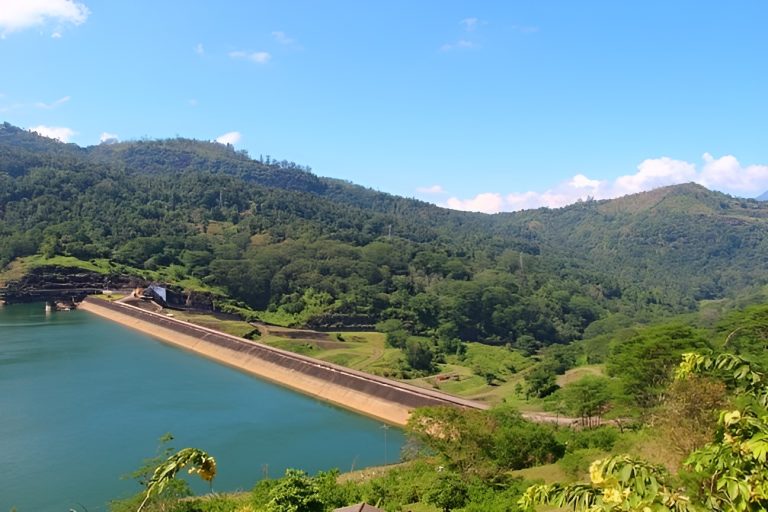Upper Kotmale Dam

Upper Kotmale Dam is a major hydroelectric dam located in the Central Province of Sri Lanka. Known for its engineering significance and the stunning scenery surrounding it, the dam is a fascinating destination for visitors interested in nature, technology, and Sri Lanka’s energy infrastructure. Here’s a comprehensive guide for beginner travelers on what to know and prepare for when visiting the Upper Kotmale Dam.
Upper Kotmale Dam: Overview
Location and Significance:
- Location: The Upper Kotmale Dam is located in the Nuwara Eliya District, near the town of Talawakele. It is part of the Upper Kotmale Hydropower Project, situated in the Kotmale Oya basin.
- Significance: This dam is a key component of Sri Lanka’s hydroelectric power generation, contributing significantly to the country’s electricity supply. The project also serves as a model for balancing environmental considerations with infrastructural development, incorporating measures to minimize ecological impact.
Key Features:
- Engineering Marvel: The dam is an impressive feat of engineering, with a height of about 35 meters (115 feet) and a length of 180 meters (591 feet). It helps to manage water flow and generate electricity, providing a unique glimpse into the country’s hydroelectric capabilities.
- Scenic Beauty: The area around the dam is characterized by lush green landscapes, tea plantations, and the dramatic terrain of the central highlands, offering breathtaking views.
- Visitor Facilities: There are facilities for visitors, including viewing platforms and information centers, where you can learn more about the dam’s construction, operation, and the environmental measures in place.
What to Have and Know Before Visiting
- Essential Items:
- Appropriate Clothing:
- Casual Wear: Wear comfortable and casual clothing suitable for walking and exploring. Given the highland climate, layering is advisable as temperatures can be cooler.
- Footwear: Sturdy walking shoes are recommended, especially if you plan to explore surrounding areas or the dam’s structure.
- Cash:
- Local Expenses: Carry cash in Sri Lankan Rupees (LKR) for any minor expenses such as parking, refreshments, or entry to specific viewing areas.
- Identification:
- ID: Bringing a copy of your passport or ID is recommended, especially if you plan to enter secured areas or require assistance.
- Appropriate Clothing:
- Travel Essentials:
- Local Currency:
- Sri Lankan Rupee (LKR): Have sufficient local currency for entry fees, local transport, and other expenses.
- Water Bottle:
- Hydration: Bring a water bottle to stay hydrated, particularly if you plan to explore extensively.
- Weather Gear:
- Sun Protection: Use sunscreen, wear a hat, and bring sunglasses, as the highland sun can be strong.
- Rain Gear: A light raincoat or umbrella can be useful, as weather in the highlands can be unpredictable.
- Snacks:
- Energy Foods: Bringing snacks is a good idea, especially if you plan to spend an extended period at the dam and nearby areas.
- Local Currency:
- Cultural Etiquette:
- Respectful Behavior:
- Quiet and Clean: Maintain a respectful demeanor, particularly in viewing areas and around local communities.
- Photography: Photography is usually allowed, but respect any restrictions, especially in sensitive or restricted areas of the dam.
- Conduct:
- Environmental Respect: Avoid littering and stay on designated paths to preserve the natural and engineered environment.
- Interaction with Locals: Be courteous and respectful when interacting with local residents or staff at the facility.
- Respectful Behavior:
- Additional Tips:
- Opening Hours:
- Access: The dam area is generally accessible during daylight hours. Check specific opening times, especially for guided tours or viewing platforms.
- Guided Tours:
- Local Guides: Consider a guided tour to learn more about the dam’s engineering, environmental considerations, and the local ecosystem. Guides can provide valuable insights and enhance your experience.
- Transportation:
- Getting There: The dam is accessible by road. You can reach it by private vehicle, tuk-tuk, or local buses from nearby towns. Ensure to confirm transport options and fares.
- Nearby Attractions:
- Explore the Area: While visiting the Upper Kotmale Dam, explore nearby attractions such as tea plantations, scenic viewpoints, or other natural sites in the region.
- Safety:
- Personal Belongings: Keep an eye on your belongings and be aware of your surroundings, particularly in crowded or more isolated areas. Follow safety instructions, especially around the dam’s operational zones.
- Opening Hours:



Responses